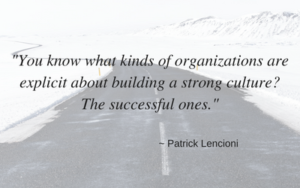 How to go about building an organizational culture? You hear this everywhere… “We’ve got to build a great culture.” “We’re going to grow our culture.” And as Chris Edmonds writes in The Culture Engine, this is a significant challenge we’re facing as leaders of companies large and small:
How to go about building an organizational culture? You hear this everywhere… “We’ve got to build a great culture.” “We’re going to grow our culture.” And as Chris Edmonds writes in The Culture Engine, this is a significant challenge we’re facing as leaders of companies large and small:
“The problem? Most leaders put greater thought into their organization’s products and services than they do its culture. Yet culture is the engine – it drives everything that happens in an organization each day. Leaders don’t want a dreary or frustrating organizational culture, but most don’t know what to do about it.” (taken from The Culture Engine: A Framework for Driving Results, Inspiring Your Employees, and Transforming Your Workplace by Chris Edmonds. Hoboken: John Wiley and Sons, 2014, p.xv.)
So what do we do about it? There are any number of good ideas out there, but few of us have the time or energy to explore them all. And a temporary fix won’t work. Most of us have tried that, either out of desperation or because a “flavor of the month” idea appeared at a time when we’re looking for low hanging fruit.
The long term solution is simple, but will require persistence and strong leadership. First, Commit to the Journey. Most executives are familiar with the concept of the “action plan” and that’s a great tool for making your commitment to the journey come to life. Write a one page commitment letter and put it at the front of your cultural “action plan.” Don’t let anyone else ghost write it for you. Make it your formal promise to the team. And make sure you sign it, which will send a powerful signal to everyone that this is a genuine commitment on your part.
Next, Establish the Framework. Review your mission, leader’s intent, values, and culture. If you don’t have them written out, take that on as the next part of your cultural “action plan”. At Level Five we call this process Setting the Azimuth – establishing the cardinal direction for your organization. The strategic planning process is typically a great time to do this work, but you don’t need to wait around until that event comes up on the calendar to set your azimuth. Later, you can use the strategic planning event as a review to ensure the azimuth is still viable. If not, then you and your leadership team can adjust it.
Third, Make Culture a Key Performance Indicator (KPI). Most of us use the KPIs as benchmarks of the health of our organization, but I’ve rarely seen culture as one of those metrics. What are some measurements you could use to make culture a KPI?
Here are some to consider:
- Internal promotions. The higher the percentage of promotions you’re making internally, the stronger your culture usually becomes. It’s important here to consider what that means in terms of leader development, too. You’ll have to invest in deliberate leadership development to set the conditions for internal promotions to be successful. And when your internal selectees do well because they were well prepared, the momentum will just continue to build.
- Storytelling. There are all kinds of good news stories in your organization, but typically we take them for granted. You can change that tendency and nurture your cultural growth by quantifying the number of stories being shared across your organization. Give your leaders goals on the number and types of good news stories they bring to the team. As we all have heard over and over throughout our professional careers, “That which is measured gets done.” Soon you won’t have to worry about leaders making these numbers, either. Good news storytelling is contagious.
- Coaching. Capture the number of coaching sessions you and your leaders are conducting on a regular basis. The most effective ones are one on one, but team coaching can be highly effective as well. Stop in and observe these sessions unannounced. Train your leaders how to coach. Put them in mock situations and see how they handle the coaching process. Soon you’ll see positive results in a number of other KPIs as you model this behavior and help others do the same. It will become “the way we do things around here.”
You and your team will be able to add other indicators to this initial list, but it’s important to build a deliberate program to improve the way of life thinking, behaving, and working that exists in your organization. Let’s get started. Put me in, Coach!
Enjoy the journey!
You can learn more about the Level 5 leadership philosophy in my book “We’re All In.” You can get a copy of the first chapter for free here.
If you’d like a full copy of the entire book, you can get it here.
Enjoy the journey!
Did you find this blog post beneficial? If so, please share it with your audience using one of the choices below. It’ll just take a second, but could improve someone’s work habits for a long time to come.





